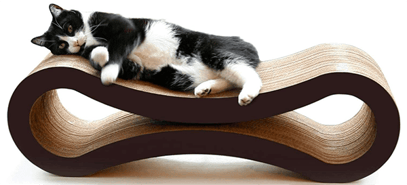
Cats scratch things. Furniture, carpet, and even wood like the trim around doors. While it’s an instinctual need for them, the damage it causes can be frustrating for us.
For many people, their gut reaction is to yell at the cat, shoo them away, or maybe even give a few squirts of water from a spray bottle.
We’ve got some much more effective tips and training techniques for getting your cat scratching appropriate things.
It’s a fact of life that cats will scratch, but also true is your ability to help control where they scratch.
Believe it or not, cats are highly trainable, and there are surfaces your cat would actually prefer to scratch even more than your furniture. It’s about figuring out what instinctual needs they’re trying to meet with their current scratching spots and giving them more acceptable ways to do that.
It's not about stopping your cat's scratching but rather appropriately meeting their needs.
Why Cats Scratch
Cats need to scratch! It’s an instinctual need programmed into their DNA. They do it for many reasons.
-
Scratching can help keep nails short. It also removes the dead outer layers of the nail.
-
Cats often like to scratch things near their favorite sleeping spots because scratching is a great way to stretch their bodies after a good nap.
-
One of the big reasons you may not be aware of is scent spreading. Cats have scent glands in their paws. They scratch to deposit that scent. And they do this for a couple of different reasons.
-
It’s a communication tool both with other cats inside and neighborhood cats outside. That’s why scratching often increases when there’s a new pet in the home or your cat sees a stranger cat outside.
-
Being surrounded by their own scent is also comforting. That means scratching is a way of self-soothing. Periods of stress can lead to increased scratching. It’s very common when a cat moves into a new home that doesn’t smell like them. Even bringing in new items that smell foreign can trigger scratching and depositing of scent.
-
-
Scratching also provides a visual communication tool, as other cats can see the scratch marks.
You can see why scratching is more than just a frustrating thing your cat does to your new sofa. It’s an important part of their “catness.”
Of course, there might be a problem when your cat’s scratching instincts meet your instinct to keep furniture in one piece.
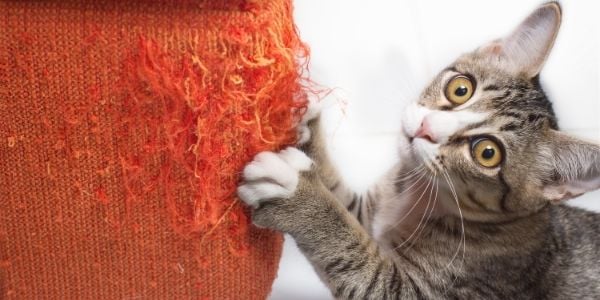
How to Keep Your Cat From Scratching Your Furniture
As I mentioned earlier, it’s not about stopping your cat’s scratching. It’s about meeting that need in a way that also works for you and then training your cat to use the preferred option.
Here are some simple steps you can take to keep your kitty from scratching your furniture to shreds while still giving them the important opportunity to do their normal and healthy scratching behaviors.
Find The 'Why'
The first step to meeting your cat’s needs is figuring out what those are. Cats have preferences, just like we do. Take a look at what your cat chooses to scratch now. What inferences can you make about their preferences? Look at a few key characteristics to figure out what your cat likes so you can replicate it in a more acceptable way.
Shape and Orientation
Your cat may not just want posts and pads that stand upright (vertical); they may want options that lay flat (horizontal) or even diagonal. Are they scratching the sides of your chair or sitting on the arm of the chair and scratching horizontally? Do they go for carpet on the floor or the edge of your mattress? These are all clues.
Even if they have a clear preference for one over the other, it’s still a good idea to give your cat choices.
Stability
Cats can put a lot of weight into scratching. Sometimes, you can feel the whole couch move. That’s often why they go for large pieces of furniture or the floor instead of the 2ft. tall cactus-shaped scratcher that falls over if you brush it walking by.
Not only could a flimsy scratching post or cat tower fall and injure your cat — or anybody else in your home — but it’s also less likely that your cat would choose to use a flimsy post or tower.
Stable, sturdy scratchers with enough weight to stay put, wall-mounted scratchers, or horizontal scratchers your cat can sit on while scratching can better replace the furniture, carpet, and walls they’re choosing to scratch now.
Size
This is especially important for vertical scratching posts and towers. Any posts and towers you get (or build) need to be tall enough for them to get a good stretch going.
If it’s a horizontal scratcher, your cat may want something large enough that they can sit or lie on top of it while scratching. Again, look at what and how they’re scratching now for clues.
Material
Good cat scratching surfaces for many cats include sisal rope, fabric, cardboard, carpet, and even uncovered wood (though you have to watch closely for splintering to prevent injury).
Your cat will probably have preferences. You may need to try different materials to see what they respond to. If they scratch upholstery or floors now, they may prefer sisal or carpet scratchers. Cardboard can be a good substitute for wood surfaces.
Location
This is a big one. We often put scratchers and cat trees out of the way — in the back bedroom or down in the basement. They don’t get used and we wonder why. It’s probably the location. Your cat isn’t going to trek across the home to get to a scratching opportunity. That’s not meeting their instinctual need to stretch after a nap, deposit their scent where they need to communicate with another cat, self-soothe, etc. Your cat is telling where they need to scratch by what they’re choosing to use now. That’s where you want to start. Later we’ll talk about what to do if that location isn’t working for you.
Worried that getting your cat a carpet scratcher and rewarding them for using it will encourage them scratch your carpeted floors?
Sure, it’s possible, but not that likely. Your cat isn’t randomly looking for anything carpeted to scratch (or whatever their preferred material is). They’re looking for something that meets all the needs we’ve discussed — size, orientation, location, material. If they’re choosing to scratch the carpeted floor instead, you’ve got this article full of tips to help redirect them.
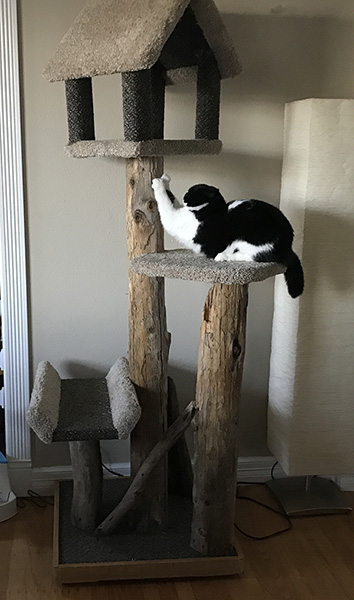 Here's Mazel, a Preventive Vet team member, using his fave cat tree that was found at a second-hand store. What a score! It has lots of different types of textures and levels. He loves it.
Here's Mazel, a Preventive Vet team member, using his fave cat tree that was found at a second-hand store. What a score! It has lots of different types of textures and levels. He loves it.
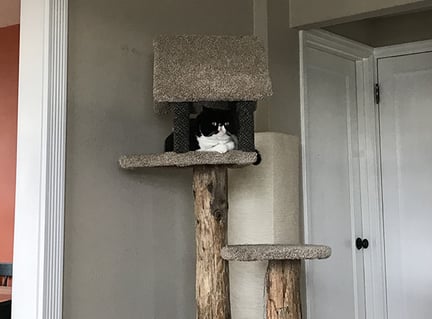
Getting Your Cat to Use Their Scratchers
Cats don’t look at a scratcher and know they’re supposed to use that instead of the couch. It’s all the same to them. That’s why it takes a combination of setup and training to encourage your cat to use the preferred scratching spots.
Location, location, location
Just like in real estate, where you put your cat’s scratching posts and pads is important. After all, if they’re in a place your cat rarely ventures to, they’re not likely to be used.
Put structures in the spaces where they hang out most.
Better yet, place them next to, or even in front of, the things your cat is currently scratching. They’ve already shown you that location works for them. Once they’re using the new scratcher reliably you can slowly move it to a better location for you and see if they keep using it.
Make unwanted scratching spots unattractive for scratching
Just adding new scratchers won’t discourage your cat from continuing to use what’s been working for them. So, make those things less appealing to scratch.
Try these tactics on the items you don't want them to scratch:
-
Drape a blanket over them
-
Add Sticky Paws double-sided tape (which is made specifically for cats)
-
Put the new scratcher over or in front of the scratching spot
-
Block or cover it with a small piece of furniture, laundry basket, plastic carpet protector, etc.
NOTE: Never use things like shock mats, spike mats, or punishment (like squirting with water, which I admit I did years ago). These are stressors that can lead to fearful, nervous behavior and damage your relationship over time. Even something like a motion-activated air can has the potential to increase stress and fear.
Training and positive reinforcement
Rewarded behaviors are more likely to be repeated. Give your cat some praise, pets, play, or treats when you see them scratching their new posts and pads. This will help ensure they’ll continue to exercise their scratching needs on those surfaces.
What about when you catch them scratching the surfaces you don’t want them to? Don’t yell or punish them. Instead, neutrally interrupt the scratching and show them what you’d prefer they do.
Why does the interruption need to be neutral? Because scratching unwanted objects can turn into an attention-seeking behavior if it gets you to stop what you’re doing and engage with your cat. Talking to them, holding them, even punishment can be seen as attention to a cat who needs engagement.
Once you’ve neutrally interrupted the scratching, you can lure them to the preferred scratcher using toys, treats, calling them, etc. If they start scratching where you'd like, praise and reward them.
Manage your cat's nails
Since trimmed cat nails can do less damage to your furniture than razor-sharp daggers, keeping your cat’s claws trimmed can be helpful.
If your cat doesn’t love nail trims, check out our article on how to get your dog used to nail trims. The process of taking baby steps and using positive reinforcement works for both dogs and cats.
Cat Scratchers Don’t Have to Be an Eyesore
Many people don't have enough scratching posts and pads around their homes because they aren’t always the nicest things to look at.
But there are some great options out there. Whether you’re a fan of raw woods, plush fabrics, or minimalist lines, cat scratchers are now designed to fit most styles and budgets. This PetFusion scratcher has nice lines and the shape makes them a great lounging spot for cats who like to scratch and stretch after a nap.
We're really loving Tuft and Paw. They have some beautiful, functional, and well-crafted designer cat furniture options. Although they can be pricey, they are known for quality.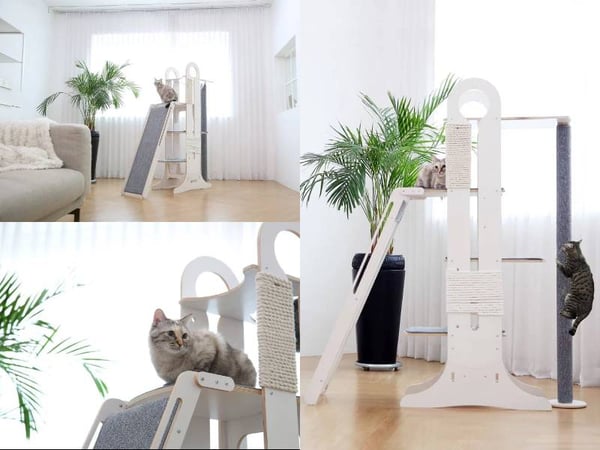
Try Different Kinds of Scratchers
For vertical scratching cats who like to hit the sides of furniture, try a wall-mounted option like this.
Here’s a cat tree option that combines natural wood and fluffy beds.
Short on floor space? Try a tall, skinny tree like this one.
There are scratchers that attach directly to furniture, like this couch corner style or couch end wrap style.
You can also find some beautiful scratchers on Etsy, just remember your cat's needs outlined above when choosing a style.Try attractants. Many cats go crazy for catnip, and you can use that to your advantage. Either sprinkle some dried catnip on your cat’s scratching posts and pads, or spritz with some catnip spray. Silvervine can also work well.
As long as the new scratchers are meeting the same needs as the unwanted scratching spots, you neutrally interrupt the unwanted scratching behavior, and you reward the wanted scratching behavior, your cat should learn pretty quickly that scratching this gets them rewards, while scratching that gets them nothing at all. They’re going to choose the option that gets them good stuff.



